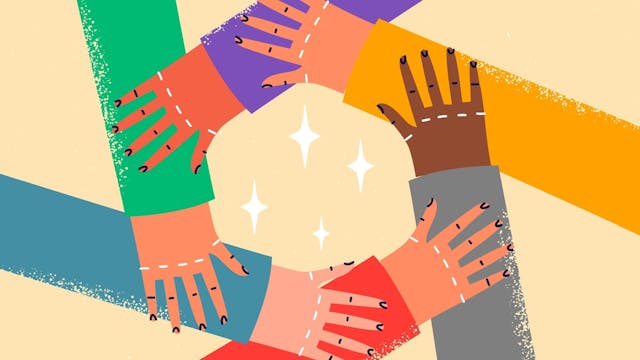This is the second in a three-part series of conversations with Latino educators and edtech experts. Read the first part here.
As Latino children make up a growing proportion of public school students in the United States, they’re also facing unique challenges.
Education researchers now know that Latino students were dealt an outsized blow to their learning by the coronavirus pandemic. A frustrating combination of factors is keeping Latino students underrepresented in science, technology and math classes. Undocumented students — many of them from Mexico and Central America — are seeing their college dreams disappear as legal protections for them remain in limbo.
Latinos who work in education are ready for change, and they say their culture already holds dear values like community-building and generosity that are needed to improve education for their students.
EdSurge recently posed a question to a panel of three educators and an edtech CEO: What is the greatest strength that Latinos can leverage to transform public education?
Strength in Numbers
For edtech CEO Rocío Raña, who co-founded a company that assesses reading skills for bilingual children, the answer is obvious.
“I'm based in New York, so I know that Latinos represent 40 percent of the student population,” she says of the schools there. “With numbers comes strength, and we need to realize that numbers are powerful.”
Persevering Through Tough Times
While other American communities might have tales of coming to the U.S. far in their past, Latinos are unique in that many students and teachers are the children or grandchildren of immigrants — or immigrants themselves.
Cindy Noriega, a high school teacher in California, says that culture of perseverance reveals the strength of Latinos writ large. Her own parents immigrated from Mexico when they were still in their teens. Her dad started work in construction at 14 and her mother worked in what Noriega describes as a sweatshop at 15.
“These were not easy things, but it taught them and they kept on persevering so that they could ultimately buy a house, have a better life, and give a better life to me and my sister,” Noriega says.
She remembers, as a child, sitting on the stairs of the homes her mother cleaned as a maid and absorbing the importance of a strong work ethic.
“I didn't end up going to build houses or clean houses, but I applied that perseverance when I was at UCLA at two in the morning trying to teach myself abstract algebra,” Noriega says, “and there was nobody else around me to teach it.”
That level of perseverance is possible for anyone of any ethnicity, she explains, but Latino students in particular need to hear it. Noriega has made a point of encouraging Latino students at her school to take computer science classes.
As soon as they face a tough math problem, Noriega says her Latino students are quick to declare they can’t do it because they simply don’t have the smarts. That’s a misconception that needs to be dispelled, she adds.
“I really do believe it's in our DNA as Latinos to be perseverant, to keep pushing, and to not give up, especially in these areas of math and computer science,” she says. “I know they are persevering because I know their stories. I know where they're coming from. I know their parents have taught them perseverance. They just need to be reminded that they're capable of that perseverance.”
A Community Built on Connection
One of the biggest strengths Latinos can bring to education is their sense of community, says Edward Gonzalez, director of open educational resources for the Kern County Superintendent of Schools in California.
It’s generally a culture of helpfulness and inclusivity, he expands, one that uplifts everyone.
“I've seen when we're building, we're building with everybody in that community, meaning that we're always bringing people in,” Gonzalez says, “whether it's offering people to come to the party that are down the street or inviting people to play a pickup game. Or telling them, ‘Hey, take a plate with you.’ The biggest contribution that we have to make is that we're always building with everybody in our vicinity.”
The Desire to Be Seen
Antonio Vigil may serve as director of innovative classroom technology at Aurora Public Schools in Colorado, but many of his ideas around improving education for Latino students have to do with strengthening human connections.
Latinos bring that to the table with the value they place on “humility and our generosity and our undeniable sense of interconnectedness,” he says.
“No matter where we go, we always make sure that people are taken care of. We always make sure that there's a sense of belonging. We always make sure that we are giving away,” Vigil says.
And in that, he sees opposing forces between how Latinos operate in their lives and how the education system as a whole prioritizes improvements for individual students.
“Why we haven't necessarily achieved the success that we want, especially academically,” he explains, “is because we are working in opposition to a collective culture.”
Instead, Vigil says Latino educators are working in a mainstream society “which says we are individual entities and we're out for ourselves. And it's about accumulating materials. It's about accumulating commodities and products, power and prestige.”
In his experience, Latinos aren’t interested in that, he says. Rather, they would be able to flourish if given the leeway to bring their full selves and values to the education realm.
“You can't be in East LA and tell us not to build our cultures of learning in the way that are indigenous to that community,” Vigil says. “You can't be in North Denver or Southside Chicago and not incorporate the indigenous beliefs that are responsible for bringing integrity and perseverance within those respective communities.”


